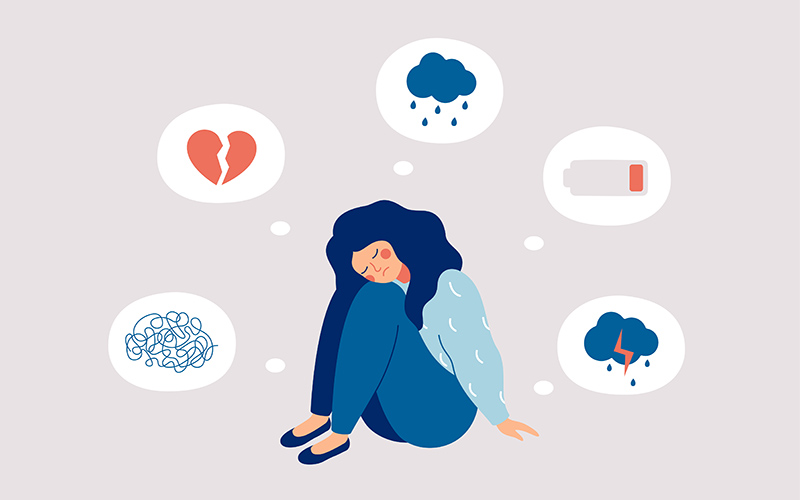
Self-Belief Update and Self-Protection
Across our lifespan, we continue to experience fluctuations of positive and negative feedback/outcomes regarding the self in interpersonal and achievement contexts. The manner in which we process and respond to these self-threatening and self-enhancing outcomes appears to change as we age. For example, our study (Yoon, Somerville, & Kim, Nat Comms, 2018) found that while younger youths immediately express aggression toward the person who provides them with negative feedback via VMPFC activity, older youths integrate multiple feedback that they receive via RMPFC/VMPFC and PCC activity and express aggression to innocent others when accumulated evidence suggests their negative social standing. Supplementary analysis has revealed that this feedback accumulation effect is also associated with low self-esteem which was found to increase with age. This result indicates that adolescent development is related to the brain’s tendency to “integrate” rather than “immediately react” to social feedback and it may be linked to the increased risk of internalizing symptoms in adolescence. Our lab plans to extend this work in multiple ways (see the research questions below) and aim to understand age-related changes and depression-related alterations in an individual’s self-belief updating system and ego-protection behavior.
Below are a few examples of research questions that we plan to pursue:
- What is the best neurocognitive model that explains the self-belief updating system in different age groups? How and why does each age group differ in the ability to change negative (positive) self-belief after receiving positive (negative) feedback?
- Is the developmental increase in feedback integration specific to social contexts or is it generalizable to non-social contexts?
- What are the experiential risk (e.g., repeated failures) and protective factors (e.g., unconditional support from parents) of developing persistently negative self-belief?
- How do optimal ego-threat responses, such as integrating constructive negative feedback while deflecting insulting negative feedback, mature across development?

Adaptive and Maladaptive Internally-Oriented Cognitions
Another intriguing finding of Yoon et al. (2018) (see above section for description) is that the function of the default mode network (DMN) in integrating self-relevant information reveals an age-related advancement during adolescence. This result could be related to the observation that rumination—an internally oriented cognition focused on the negative aspects of the self—increases during adolescence and is associated with alterations in DMN functions and connectivity. Relatedly, our recent study (Yoon et al., 2023 DCN) revealed that adolescent girls with a high tendency for rumination showed heightened DMN activity and diminished DMN connectivity with affective brain regions when they receive negative social evaluation. Meanwhile, DMN functions and connectivity have also been linked to adaptive forms of internally oriented cognition—such as social memory, creativity, and perspective-taking—that matures during adolescence. These pieces of evidence indicate that DMN maturation may serve both risk and opportunity in the context of adolescent cognitive development. Our lab aims to advance our understanding of adolescent DMN development in relation to different types of internally oriented cognitions. By doing so, we aim to prevent the excessive development of maladaptive internally oriented cognition while preserving the development of adaptive internally oriented cognition in adolescence.
The following are the example research questions that we plan to pursue:
- What are the neurodevelopmental mechanisms of adolescent-specific increases in rumination? For example, is the transition to adolescence associated with difficulty turning off DMN activity during cognitive tasks following social evaluative threat? Are sex differences in DMN maturation related to the emergence of sex differences in rumination?
- Across modalities (e.g., structural/functional connectivity and task-related activation), which properties of DMN development are commonly or distinctively associated with the maturation of adaptive and maladaptive internally oriented cognition?
- Which lifestyle factors (e.g., sleep deprivation and excessive social media use) hamper the development of adaptive switching between internally and externally oriented cognition?

Social Competence and Social Learning
Social neuroscience research has accumulated knowledge on the neural mechanisms underlying social intelligence. For example, our research (Yoon et al., SCAN, 2021) has revealed that MPFC/ACC and AI, where Von Economo Neurons (the neurons that facilitate rapid brain–body communications) exist, play a critical role in aligning one’s behavior to social norms. Although adolescence is an important period for developing diverse social-cognitive abilities in order to lead a successful and happy adulthood, developmental neuroscience is in its early stage in characterizing the neurodevelopmental basis of social competence in adolescence. Our lab joins the effort to address this gap by investigating the neurodevelopment of social-cognitive abilities such as initiating and maintaining friendships, aligning one’s behavior to social expectations, respecting others with different values, and regulating complex social emotions (e.g., envy and shadenfreude). Beyond typical social development, our lab is also interested in how social development is affected by common mental disorders, such as depression, given the overlapping neural circuitry required for healthy social and emotional functioning.
The example research questions that we plan to pursue are listed below:
- How does the youth’s ability to acquire and apply social norms (i.e., learning which behaviors are socially valued and select behaviors that maximize one’s social value) develop and how is this ability affected by depression?
- Which neurobiological changes support the development of experiencing and regulating complex social emotions (e.g., envy and schadenfreude)?
- Why do certain adolescents exhibit more significant growth and higher levels of openness to different values and opinions? How do neurodevelopmental differences contribute to this individual difference?

Youth Depression
Adolescent depression is becoming an increasingly severe societal problem worldwide. According to a 2019 report, 15.8% of adolescents reported that they experienced major depression episodes in the last year, which was 7.7% higher than the report in 2009. Because adolescent-onset depression causes much more adverse outcomes across psychological, social, and occupational functioning than adult-onset depression, it is critical to prevent depression early in adolescence. With the aim of preventing depression and treating maladaptive cognitions of depressed youth, our research has identified neurocognitive risk factors (e.g., reduced threat-related amygdala connectivity) (Yoon et al., 2021, JCPP) and social consequences (e.g., being overly nurturant) (Yoon et al., in prep) of depression in adolescents. To provide further sophistication in the neurocognitive and interpersonal models of depression in youth, our lab will continue to investigate the risk factors, correlates, and consequences of depression in adolescence in relation to three neural and psychological processes that we focus on—self-related processing, internally oriented cognitions, and social behaviors.
We plan to pursue the following example research questions in this regard:
- Why do depressed adolescents exhibit persistently negative self-belief even when they experience positive outcomes? Do they experience difficulty integrating positive feedback into their self-concept or do they excessively integrate negative feedback into their self-concept?
- Is adolescent depression and rumination related to altered VMPFC functions that supposedly support self-protection (e.g., external attribution) from threats to self-esteem?
- Apart from alterations in social reward and threat processing, do depressed adolescents exhibit difficulties in social learning, such as learning which actions lead to praise and criticism and modifying one’s behavior accordingly?
